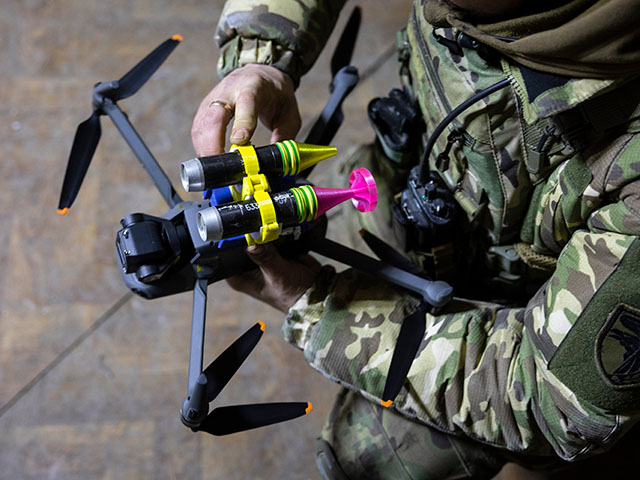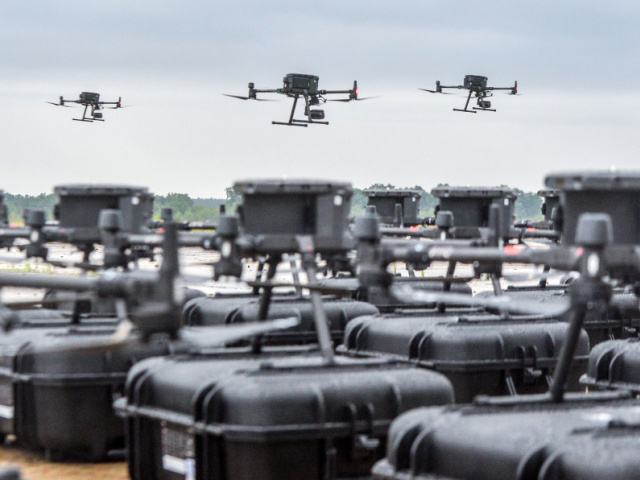2023 was a landmark year for drone warfare as the use of unmanned aerial vehicles (UAV) became increasingly widespread among combatants of every size and ideology.
It was also a major year for anti-drone defenses, which have evolved to the point where drones are no longer the seemingly unstoppable phantom menaces they were a few years ago.
One of the most spectacular examples of anti-drone warfare came near the end of the year, as the U.S. Navy destroyer USS Carney engaged and destroyed a swarm of 14 drones launched by the Iran-backed Houthi terrorists of Yemen.
The battle, fought in the early morning hours of December 18 in the Red Sea, pitted the Arleigh Burke-class destroyer against what the U.S. Central Command (CENTCOM) described as “one-way attack drones.”
USS Carney destroyed all of the attacking UAVs without any damage to itself or other ships in the area. CENTCOM did not disclose extensive details about how the Carney detected and destroyed the Houthi drones or whether the Carney was the intended target of the swarm.
In October, USS Carney intercepted a barrage of drones and missiles launched by the Houthis against targets in Israel, destroying four cruise missiles and 15 drones for nine hours.
Another American destroyer, USS Mason, the British Royal Navy warship HMS Diamond, and the French frigate FREMM Languedoc also intercepted Houthi missiles and drones over the Red Sea in multiple engagements.

In this image released by the U.S. Navy, the USS Mason (DDG 87), conducts maneuvers as part of a exercise in the Gulf of Oman on Sept. 10, 2016. (Mass Communication Specialist 1st Class Blake Midnight/U.S. Navy via AP)
British Defense Minister Grant Shapps said the Diamond was able to destroy a drone with a Sea Viper missile, a surface-to-air weapon system designed to intercept both enemy missiles and aircraft. Drones were not a threat on anyone’s figurative radar screen when the Sea Viper system was designed, but it appears to have quickly adapted to drone warfare.
The Houthis made extensive use of drones to enforce their blockade against Israel in an effort to help the Hamas terrorists withstand Israel’s counter-terrorism operation in Gaza. After weeks of Houthi terrorism began shutting down vital Red Sea shipping routes, including oil shipments from London-based oil giant BP, the United States launched a multinational defensive effort called Operation Prosperity Guardian, with a task force dedicated to protecting cargo ships in the Red Sea.
The Houthis’ use of drones is interesting because there were few confirmed reports of their UAVs causing significant damage to shipping, and Western naval forces developed a high level of proficiency at intercepting and destroying them, but the terror of knowing the skies could be filled with suicide drones had a substantial terrorizing effect on civilian shipping companies.
One reason drones have such an outsize terror effect is that they can be deployed without much preparation by mobile launch teams and loiter for some time before acquiring targets. Drone intercepts became more common in 2023, but it remains more difficult to strike back against the launchers, the way missile threats can be degraded by targeting launch sites. The Houthis could launch another dozen-drone swarm against USS Carney any time they want a rematch.

This photo released by the Houthi Media Center shows a Houthi forces helicopter approaching the cargo ship Galaxy Leader on Sunday, Nov. 19, 2023. (Houthi Media Center via AP)
Drones continue to play a major role in Russia’s invasion of Ukraine. Russia adapted quickly after Ukraine’s early successes with Turkish-made Bayraktar attack drones, stepping up its own drone attacks and improving its defensive tactics.
Ukraine still believes it has a drone advantage. Its inventory swelled in 2023 to include at least 50 different models for reconnaissance and attack, with a production target of at least 100,000 units a month. However, international military analysts believe Russia has developed a significant advantage in counter-drone electronic warfare.
Ukrainian drones have been especially effective at harassing Russia’s Black Sea fleet and destroying Russian armor. Russian tank crews have reportedly taken to referring to Ukraine’s anti-tank drones as “Baba Yaga,” a nickname from Russian folklore that will be familiar to fans of the John Wick movies.

A Ukrainian military man equips and prepares a drone for flight and prepares ammunition at positions 4 kilometers from the frontline as the special unit “Achilles” is preparing to carry out a combat mission at night on the heavy drone “Vampire”, which the Russians call “Baba Yaga” on November 12, 2023 in the Bakhmut District, Ukraine. (Photo by Kostya Liberov/Libkos via Getty Images)
Ukraine’s appetite for drones is so voracious that battlefield technicians and civilian volunteers are cobbling militarized drones together out of everything they can find, producing “attack drones” that are little more than consumer-grade UAVs with hand grenades zip-tied to their bodies. In December, PBS interviewed a Ukrainian volunteer drone unit whose UAV was made of foam and held together with duct tape.

A drone operator with the Ukrainian Army’s 93rd Brigade attaches grenades to a DJI Mavic 3 drone on February 18, 2023, in Bakhmut, Ukraine. Photo by John Moore/Getty Images)
The Ukrainian military has also made some state-of-the-art investments in UAV warfare. In October, a Ukrainian manufacturer called Saker claimed to become the first operation to deploy fully autonomous artificially intelligent (A.I.) weapons in battle. Saker said networks of its drones — fairly cheap vehicles running very expensive A.I. software — have been deployed “on a small scale” to seek and destroy targets without human operators.
Russia rapidly scaled up its drone inventory with assistance from Iran, to the great consternation of Western officials. Russia has launched several massive waves of Iranian kamikaze drones at Ukrainian cities. The Ukrainians claim to have intercepted most of them.
The White House said Russia plans to begin producing Iranian-designed drones on a large scale in 2024 as part of a “deepening” military partnership. The U.S. imposed several rounds of sanctions against the Russian-Iranian drone complex, most recently on December 19.

Russian President Vladimir Putin (L) meets with Iranian President Ebrahim Raisi (R) in Tehran ahead of on July 19, 2022. (Photo by Iranian Presidency/Handout/Anadolu Agency via Getty Images)
“Iran’s illicit production and proliferation of its deadly UAVs to its terrorist proxies in the Middle East and to Russia continues to exacerbate tensions and prolong conflicts, undermining stability,” Undersecretary for Terrorism and Financial Intelligence Brian Nelson said when the latest sanctions were announced.
By the end of 2023, Russia and Ukraine were launching major drone attacks against each other regularly. Both sides claim they can intercept most of the incoming enemy drones, but the units that get through can inflict significant damage. Ukrainian President Volodymyr Zelensky has said American-made advanced air defense systems are crucial for repelling Russian drone attacks.
Drones are playing a major role in the Gaza war, where the terrorists of Hamas have been disturbingly successful at penetrating Israel’s sophisticated defenses with cheap commercial drones and kit-bashed designs similar to those produced by Ukraine’s resourceful homebrewed drone industry.
Hamas drones were integral to the October 7 atrocity, paving the way for the infamous paragliding death squads and rape gangs by taking out Israeli cameras and communications. Unverified Hamas online videos depict its cheap drones dumping grenades on Israeli soldiers and vehicles.
The Israeli Defense Forces (IDF) has drones too, of course, using them extensively to scout for ambushes and booby traps and spot targets for air attacks.
Pentagon acquisition chief Bill LaPlante said in December that cheap drones have proliferated like wildfire in conflict zones around the world, making the development of better anti-drone equipment a high priority. LaPlante said the U.S. has fallen behind on drone defenses as military drone usage exploded around the world over the past few years.
One reason for the huge popularity of even the simplest drones is that many of the world’s armed forces, including Russia and Ukraine, have large inventories of older weapons designed to intercept large piloted aircraft. These older systems are not very good at shooting down tiny, agile drones.
Russia appears to have concluded the best way to fight drones is to fortify their front lines with powerful signal jammers that interfere with control transmissions. Ukrainian forces are attempting to mimic this defensive tactic by reverse-engineering Chinese anti-drone devices to create their own domestically produced signal jammer, dubbed the “Oberih.”
Western defense forces have created some expensive and sophisticated weapons for intercepting drones, including the U.S.-made Vampire system. Produced by L3Harris, the Vampire is essentially a sophisticated laser-guided missile launcher that can be mounted in the back of a pickup truck. A Vampire laser targeting system and missile launcher can be installed in a stock pickup truck in about two hours and can be operated by a single soldier.
Israel rolled out the Iron Beam defense system in 2023. Iron Beam is not a laser-guided missile system — it is a straight-up laser weapon that can intercept drones, missiles, and even artillery shells with a 100-kilowatt laser beam. The system has been rushed into final testing and could see significant deployment as early as next year.

U.S. President Joe Biden (6- L) listens to Israeli Defence Minister Benny Gantz (5- L), as they tour Israel’s missile defence systems Iron Beam (L) and Iron Dome (R) at Ben Gurion Airport near Tel Aviv on July 13, 2022, with caretaker Prime Minister Yair Lapid (5- R), Israeli expert on technology and innovation Daniel Gold (4- L), Israeli army Chief of Staff Aviv Kohavi (5- L) and US Defence Attache in Israel, Brigadier General Shawn A. Harris (4nd R). (GIL COHEN-MAGEN / POOL / AFP)
Iron Beam has the tremendous advantage of not requiring expensive ammunition or time-consuming reloads but works at much shorter ranges than Israel’s fabled Iron Dome interceptor missiles, and it takes a few seconds for the laser to destroy each target compared to missile and shell weapons that can fire more rapidly.
The U.S. is developing its own version of Iron Beam, potentially with an upgrade to 300-kilowatt lasers that could destroy targets much more quickly, making the system more effective against swarms of drones or missiles.
Israeli volunteers pioneered another interesting anti-drone system during the Gaza war: a smartphone app that can turn two linked phone cameras into a surprisingly effective system for visually detecting inbound drones.
Israeli engineers were reportedly developing an electronic warfare defense that could take control of incoming drones, a step up from Russia’s tactic of blasting the sky with electronic noise to disrupt control signals. The developer of this system, Sentrycs, mournfully revealed it was only a week away from going live when Hamas attacked on October 7.
The future of drone warfare may involve developing more sophisticated, and less expensive, A.I. drones that can operate autonomously, reducing the effectiveness of electronic warfare defenses focused on jamming operator signals.
2023 was a landmark year for putting precision targeting weapons, previously the exclusive domain of the world’s largest and most advanced military forces, into the hands of nearly every combatant. On battlefields around the world, soldiers are hiding inside buildings, taking cover under trees, and trying to shoot drones with their rifles as ominous buzzing sounds fill the air around them.
The Pentagon responded to this growing threat in October by establishing a school of anti-Unmanned Aerial Systems (UAS) warfare at Fort Sill, Oklahoma. This Joint Counter – small UAS University (Joint C-sUAS) will train about a thousand soldiers each year to use a rapidly evolving arsenal of defensive equipment and tactics to combat equally rapidly evolving drone threats.
“The exponential growth of UAS as a threat to U.S. and Coalition forces and U.S. government installations at home and abroad drove the need to create a centralized and standardized training institution,” said Lt. Col. Moseph Sauda, head of the Joint C-sUAS school.
“The threat dictates what system is best for defeat. Therefore, the JCU trains across the spectrum of available systems and updates its curriculum and systems accordingly in order to maintain pace with the emerging threats,” Sauda said.
Sauda added that another key goal of the training program will involve the rules of engagement (ROE) for drone warfare, which are still being drafted and revised as equipment and tactics change rapidly in battlefields like Ukraine. One unique ROE challenge for drones is their increasing presence in civilian life around the world. It is fairly obvious when a manned warplane attacks, but soldiers in every army are still struggling to learn what it means when they hear the buzz of a tiny drone.


COMMENTS
Please let us know if you're having issues with commenting.